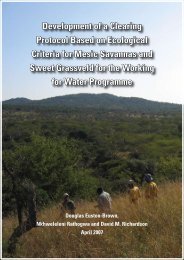Metsi Consultants - DWA Home Page
Metsi Consultants - DWA Home Page
Metsi Consultants - DWA Home Page
Create successful ePaper yourself
Turn your PDF publications into a flip-book with our unique Google optimized e-Paper software.
Report No 678-F-001<br />
METSI CONSULTANTS: SUMMARY OF MAIN FINDINGS FOR PHASE 1 DEVELOPMENT<br />
Any compensation programmes aimed at the areas downstream of the LHWP structures would assumedly form<br />
part of the overall LHWP-compensation programmes, which are presently all concerned with items upstream of<br />
the LHWP structures and are embodied in the respective Phase 1A and 1B Environmental Action Plans. The<br />
current plans make no provision for downstream compensation, although they do address monitoring of<br />
downstream impacts on a long-term basis.<br />
A key feature of the LHWP compensation programme as implemented upstream is that compensation-in-kind has<br />
dominated the transactions. Lost production from land has been replaced by maize and pulses delivered to<br />
communities; and livestock fodder was initially offered as a replacement for range forage. Social forestry<br />
programmes have attempted to provide replacement trees for lost timber and fuel resources. Where communities<br />
have accepted cash as a compensation measure, it has been directed to specific affected households. Virtually<br />
all lost community assets such as communal land resources have been replaced by resources other than cash.<br />
11.4. POTENTIAL MITIGATION AND COMPENSATION APPROACHES<br />
The following is a brief review of potential mitigation and compensation approaches for downstream river<br />
reaches. More detailed analyses will be presented in future separate reports under Contract 678.<br />
11.4.1 Fisheries<br />
Cash compensation for lost fish harvests would not be workable in the case of downstream communities because<br />
of a lack of supply outlets for any fish or fish substitutes. The present fishery programme in Phase 1A is directed<br />
at the utilisation of the abundant fish populations in Katse Dam. The programme seeks to provide training to<br />
communities in fishing techniques and in methods of regulating harvests for long-term sustainability. Reservoir<br />
fish populations available for such harvesting are a natural product of reservoir formation and were not<br />
established specifically for utilisation purposes. The biological situation downstream is quite different - fish<br />
populations and associated harvests would be limited by stream flows and lack of available wetted habitats.<br />
Supplementation of fish populations for harvesting by local communities is theoretically possible through the<br />
establishment and operation of hatcheries and fish rearing facilities, but releasing fish into water-depleted rivers<br />
would be a largely pointless exercise. Fishery enhancement thus seems potentially more feasible in river reaches<br />
that are distant from the LHWP structures, which receive flows from tributaries not affected by flow regulation,<br />
and that have the advantage of accessibility from existing roads.<br />
Local people utilise fish primarily as a food resource, and the aesthetics of fishing are secondary and likely a<br />
minor concern. An alternative form of compensation would therefore be one that supplements the food quantity<br />
and quality available to downstream communities. These are mentioned further below.<br />
11.4.2 Medicinal Plants<br />
Estimated losses for the medicinal plant resources are comparatively low (about M83,000 annually for the Treaty<br />
Scenario) but overall biomass and cash values are not the only important parameters for medicinal plants -<br />
diversity and availability are also significant. Cash compensation is not a ready substitute for the lost resource<br />
because of the biological diversity, strong local beliefs in the efficacy of herbal medicines, and a lack of locally<br />
available substitutes.<br />
In determining compensation approaches to medicinal plants, it is important to identify the main target of the<br />
compensation - the source or the users. Plants used for medical purposes are in great demand in the upstream<br />
63

















